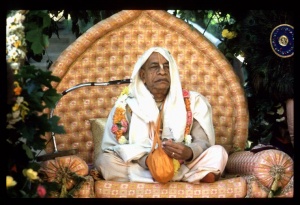CC Adi 17.124: Difference between revisions
m (1 revision(s)) |
No edit summary |
||
| Line 1: | Line 1: | ||
{{ | [[Category:Sri Caitanya-caritamrta - Adi-lila Chapter 17|C124]] | ||
<div style="float:left">'''[[Sri Caitanya-caritamrta|Śrī Caitanya-caritāmṛta]] - [[CC Adi|Ādi-līlā]] - [[CC Adi 17|Chapter 17: The Pastimes of Lord Caitanya Mahāprabhu in His Youth]]'''</div> | |||
<div style="float:right">[[File:Go-previous.png|link=CC Adi 17.123|Ādi-līlā 17.123]] '''[[CC Adi 17.123|Ādi-līlā 17.123]] - [[CC Adi 17.125|Ādi-līlā 17.125]]''' [[File:Go-next.png|link=CC Adi 17.125|Ādi-līlā 17.125]]</div> | |||
{{CompareVersions|CC|Adi 17.124|CC 1975|CC 1996}} | |||
{{RandomImage}} | |||
==== TEXT 124 ==== | ==== TEXT 124 ==== | ||
<div | <div class="verse"> | ||
śuniyā ye kruddha haila sakala yavana | :śuniyā ye kruddha haila sakala yavana | ||
kājī-pāśe āsi’ sabe kaila nivedana | :kājī-pāśe āsi’ sabe kaila nivedana | ||
</div> | </div> | ||
| Line 12: | Line 16: | ||
==== SYNONYMS ==== | ==== SYNONYMS ==== | ||
<div | <div class="synonyms"> | ||
''śuniyā''—by hearing; ''ye''—that; ''kruddha''—angry; ''haila—''became; ''sakala''—all; ''yavana''—Muslims; ''kājī-pāśe''—in the court of the Kazi, or magistrate; ''āsi''’—coming; ''sabe''—all; ''kaila''—made; ''nivedana''—petition. | |||
</div> | </div> | ||
| Line 19: | Line 23: | ||
==== TRANSLATION ==== | ==== TRANSLATION ==== | ||
<div | <div class="translation"> | ||
Hearing the resounding vibration of the Hare Kṛṣṇa mantra, the local Muslims, greatly angry, submitted a complaint to the Kazi. | Hearing the resounding vibration of the Hare Kṛṣṇa mantra, the local Muslims, greatly angry, submitted a complaint to the Kazi. | ||
</div> | </div> | ||
| Line 26: | Line 30: | ||
==== PURPORT ==== | ==== PURPORT ==== | ||
<div | <div class="purport"> | ||
The phaujadarā, or city magistrate, was called the kājī (Kazi). The jamidāras (zamindars), or landholders (maṇḍalerās), levied taxes on the land, but keeping law and order and punishing criminals was the duty entrusted to the Kazi. Both the Kazi and the landholders were under the control of the governor of Bengal, which at that time was known as Subā-bāṅgālā. The districts of Nadia, Islāmpura and Bāgoyāna were all under the zamindar named Hari Hoḍa or his descendant known as Hoḍa Kṛṣṇadāsa. It is said that Chand Kazi was the spiritual master of Nawab Hussain Shah. According to one opinion his name was Maulānā Sirājuddina, and according to another his name was Habibara Rahamāna. Descendants of Chand Kazi are still living in the vicinity of Māyāpur. People still go to see the tomb of Chand Kazi, which is underneath a campaka tree and is known as Chand Kazi’s samādhi. | The ''phaujadarā'', or city magistrate, was called the ''kājī'' (Kazi). The ''jamidāras'' (zamindars), or landholders (''maṇḍalerās''), levied taxes on the land, but keeping law and order and punishing criminals was the duty entrusted to the Kazi. Both the Kazi and the landholders were under the control of the governor of Bengal, which at that time was known as Subā-bāṅgālā. The districts of Nadia, Islāmpura and Bāgoyāna were all under the zamindar named Hari Hoḍa or his descendant known as Hoḍa Kṛṣṇadāsa. It is said that Chand Kazi was the spiritual master of Nawab Hussain Shah. According to one opinion his name was Maulānā Sirājuddina, and according to another his name was Habibara Rahamāna. Descendants of Chand Kazi are still living in the vicinity of Māyāpur. People still go to see the tomb of Chand Kazi, which is underneath a ''campaka'' tree and is known as Chand Kazi’s ''samādhi''. | ||
</div> | </div> | ||
__NOTOC__ | |||
<div style="float:right; clear:both;">[[File:Go-previous.png|link=CC Adi 17.123|Ādi-līlā 17.123]] '''[[CC Adi 17.123|Ādi-līlā 17.123]] - [[CC Adi 17.125|Ādi-līlā 17.125]]''' [[File:Go-next.png|link=CC Adi 17.125|Ādi-līlā 17.125]]</div> | |||
__NOTOC__ | |||
__NOEDITSECTION__ | |||
Revision as of 12:14, 24 July 2021

A.C. Bhaktivedanta Swami Prabhupada
TEXT 124
- śuniyā ye kruddha haila sakala yavana
- kājī-pāśe āsi’ sabe kaila nivedana
SYNONYMS
śuniyā—by hearing; ye—that; kruddha—angry; haila—became; sakala—all; yavana—Muslims; kājī-pāśe—in the court of the Kazi, or magistrate; āsi’—coming; sabe—all; kaila—made; nivedana—petition.
TRANSLATION
Hearing the resounding vibration of the Hare Kṛṣṇa mantra, the local Muslims, greatly angry, submitted a complaint to the Kazi.
PURPORT
The phaujadarā, or city magistrate, was called the kājī (Kazi). The jamidāras (zamindars), or landholders (maṇḍalerās), levied taxes on the land, but keeping law and order and punishing criminals was the duty entrusted to the Kazi. Both the Kazi and the landholders were under the control of the governor of Bengal, which at that time was known as Subā-bāṅgālā. The districts of Nadia, Islāmpura and Bāgoyāna were all under the zamindar named Hari Hoḍa or his descendant known as Hoḍa Kṛṣṇadāsa. It is said that Chand Kazi was the spiritual master of Nawab Hussain Shah. According to one opinion his name was Maulānā Sirājuddina, and according to another his name was Habibara Rahamāna. Descendants of Chand Kazi are still living in the vicinity of Māyāpur. People still go to see the tomb of Chand Kazi, which is underneath a campaka tree and is known as Chand Kazi’s samādhi.